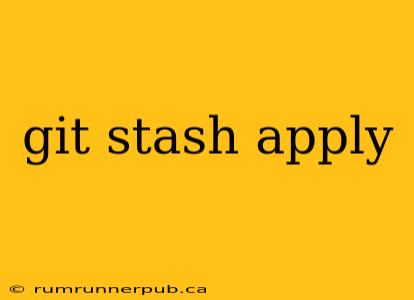Git's stash command is a lifesaver when you need to temporarily shelve your changes without committing them. This article explores the git stash apply command, drawing insights from Stack Overflow discussions and offering practical examples to solidify your understanding.
What is git stash apply?
git stash apply is used to re-integrate changes that were previously stashed using git stash push (or the shorthand git stash). Think of it as retrieving your saved work from a temporary holding area. It's incredibly useful when you need to switch branches, fix a bug urgently, or handle unexpected interruptions while working on a feature.
Stack Overflow Perspective: Many Stack Overflow questions highlight the confusion around which stash to apply (when you have multiple stashes). For instance, a user might ask: "How do I apply a specific stash?" (Similar questions can be found by searching for "git stash apply specific stash" on Stack Overflow).
Answer & Explanation: While git stash apply by default applies the most recently stashed changes, you can target specific stashes using their index number (displayed by git stash list). For example: git stash apply stash@{1} applies the second most recent stash. This targeted approach is crucial for managing multiple stashed changesets.
Common Scenarios and Best Practices
Let's illustrate with examples based on common use cases found in Stack Overflow discussions:
Scenario 1: Switching Branches mid-work.
You're working on a feature branch, but an urgent bug needs fixing on the main branch.
git stash push -u "My feature work": This stashes your changes, including untracked files, with a descriptive message.git checkout main: Switch to themainbranch.- Fix the bug and commit.
git checkout <your_feature_branch>: Return to your feature branch.git stash apply: This re-applies your stashed changes. If there are conflicts, Git will flag them, requiring manual resolution.
Scenario 2: Handling Conflicts.
Sometimes, applying a stash might lead to conflicts if the underlying code has changed since the stash was created.
Stack Overflow Insight: Questions frequently arise on resolving conflicts after git stash apply.
Resolution: Git will clearly indicate the conflicting files. Carefully review the changes, manually choose which changes to keep, and then stage the resolved files using git add <file> before committing.
Scenario 3: Applying a Specific Stash.
You have multiple stashes and need to apply a specific one.
git stash list: Displays a list of your stashes with their index numbers.git stash apply stash@{1}: Applies the second most recently stashed changes. Replacestash@{1}with the appropriate stash index.
Beyond the Basics: git stash pop and git stash drop
While git stash apply re-integrates stashed changes, leaving the stash intact, git stash pop applies the stash and removes it from the stash list. git stash drop simply removes a stash without applying it. Choose the command that best fits your workflow.
Conclusion
git stash apply is a powerful tool for managing your Git workflow effectively. Understanding its intricacies, as highlighted by various Stack Overflow discussions, allows you to leverage its capabilities to handle interruptions and maintain a clean, organized repository. By mastering git stash apply, along with its companion commands, you'll significantly enhance your Git proficiency and streamline your development process. Remember to always consult the official Git documentation for the most comprehensive and up-to-date information.
